1997 CHEVROLET BLAZER overheating
[x] Cancel search: overheatingPage 133 of 402
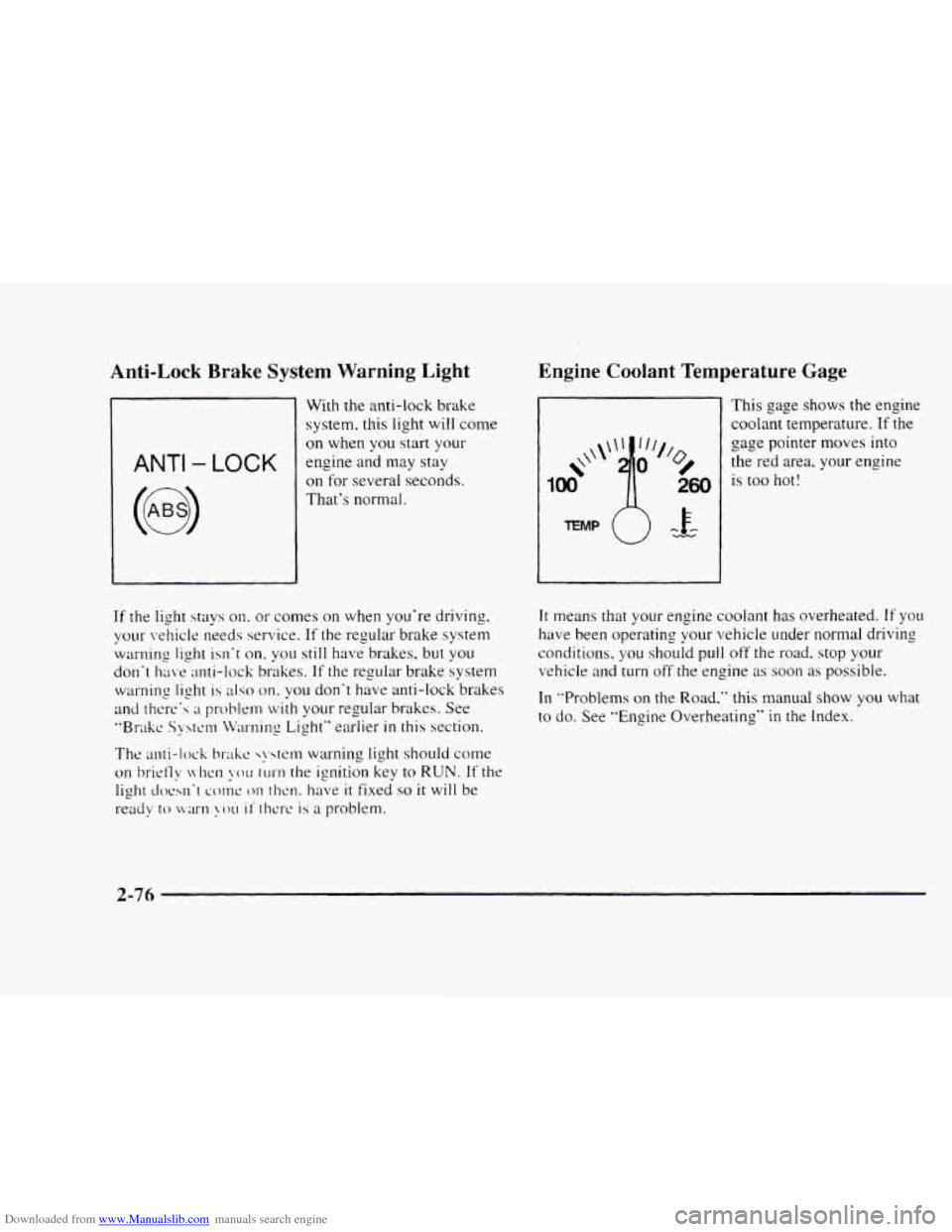
Downloaded from www.Manualslib.com manuals search engine Anti-Lock Brake System Warning Light
ANTI - LOCK
With the anti-lock brake
system, this light will come
on when you start your
engine and may stay
on for several seconds.
That's normal.
Engine Coolant Temperature Gage
This gage shows the engine
coolant temperature.
If the
gage pointer moves
into
is too hot!
the
red area, your engine 260
If the light stays on. or comes on when you're driving,
your irehick needs service.
If the regular brake system
warning
light isn't on. you still have brakes. but you
don't
have anti-lock brakes. If the regular brake system
warning light
is also on. you don't have anti-lock brakes
and there's
;I problern with your regular brakes. See
"B1-akc. Svstcm LVmling Light" earlier in this section.
The anti-lock brakc. s>.4tem warning light should come
on briet'ly n.hct1
~.ou turn the ignition key to RUN. If the
light doesn't co1nc3 011 111cn. have it fixed so it will be
ready
to w;m U)LI it' thew is a problem. lt means
that your engine coolant
have been operating your vehicle has
overheated.
If you
under normal driving
conditions. you should pull off the road.
stop your
vehicle and
turn off the engine as soon as possible.
In "Problems on the Road." this manual show you what
to
do. See "Engine Overheating" in the Index.
2-76
Page 213 of 402

Downloaded from www.Manualslib.com manuals search engine When towing a trailer, the arrows on your instrument
panel
will flash for turns even if the bulbs on the trailer
are burned out. Thus, you may
think drivers behind you
are seeing your signal when they are not. It's important
to check occasionally to be sure the trailer bulbs are
still working.
Driving On Grades
Reduce speed and shift to a lower gear byfilw you start
down
a long or steep downgrade. If you don't shift
down. you might have to use your brakes
so much that
they would get hot and no longer work well.
On
a long uphill grade. shift down and reduce your
speed
to around 45 mph (70 km/h) to reduce the
possibility of engine and transmission overheating.
if
you have an automatic transmission. you should use
DRIVE (D) when towing a trailer. Operating your
vehicle in DRIVE (D) when towing a trailer will
minimize heat buildup and extend the life
of your
transmission. Or.
if you have a manual transmission. it's
better not to use
FIFTH (5 j gear. just drive in
FOURTH (4) gear (or. as you need to. a lower gear). When
towing
at high altitude on steep uphill grades.
consider the following: Engine coolant will boil at a
lower temperature than at normal altitudes.
If you turn
your engine off immediately after towing at high altitude
on steep uphill grades, your vehicle may show signs
similar to engine overheating.
To avoid this. let the
engine
run while parked (preferably on level ground)
with the automatic transmission in PARK (P) (or the
rnanual transmission out of gear and the parking brake
applied) for a few minutes before turning the engine off.
If you do get the overheat warning, see "Engine
Overheating"
in the Index.
Parking on Hills
You really should not park your vehicle. with a trailer
attached.
on ;I hill. If something goes wrong, your ris
could start to move. People can be injured, and both
your vehicle and the trailer
can be damaged.
4-52
Page 218 of 402

Downloaded from www.Manualslib.com manuals search engine Section 5 Problems on the Road
Here you'll find what to do about some problems that can occur on the road.
5 -2
5-2
5-3
5 -7
5-12
Hazard Warning Flashers
Other Warning Devices
Jump Starting
Towing Your Vehicle
Engine Overheating
5-22
5 -22
5-23
5-35
5-36
Engine Fan Noise
If a Tire Goes Flat
Changing a Flat Tire
Compact Spare Tire
(If Equipped)
If You're Stuck: In Sand, Mud,
Ice or Snow
5-1
Page 229 of 402
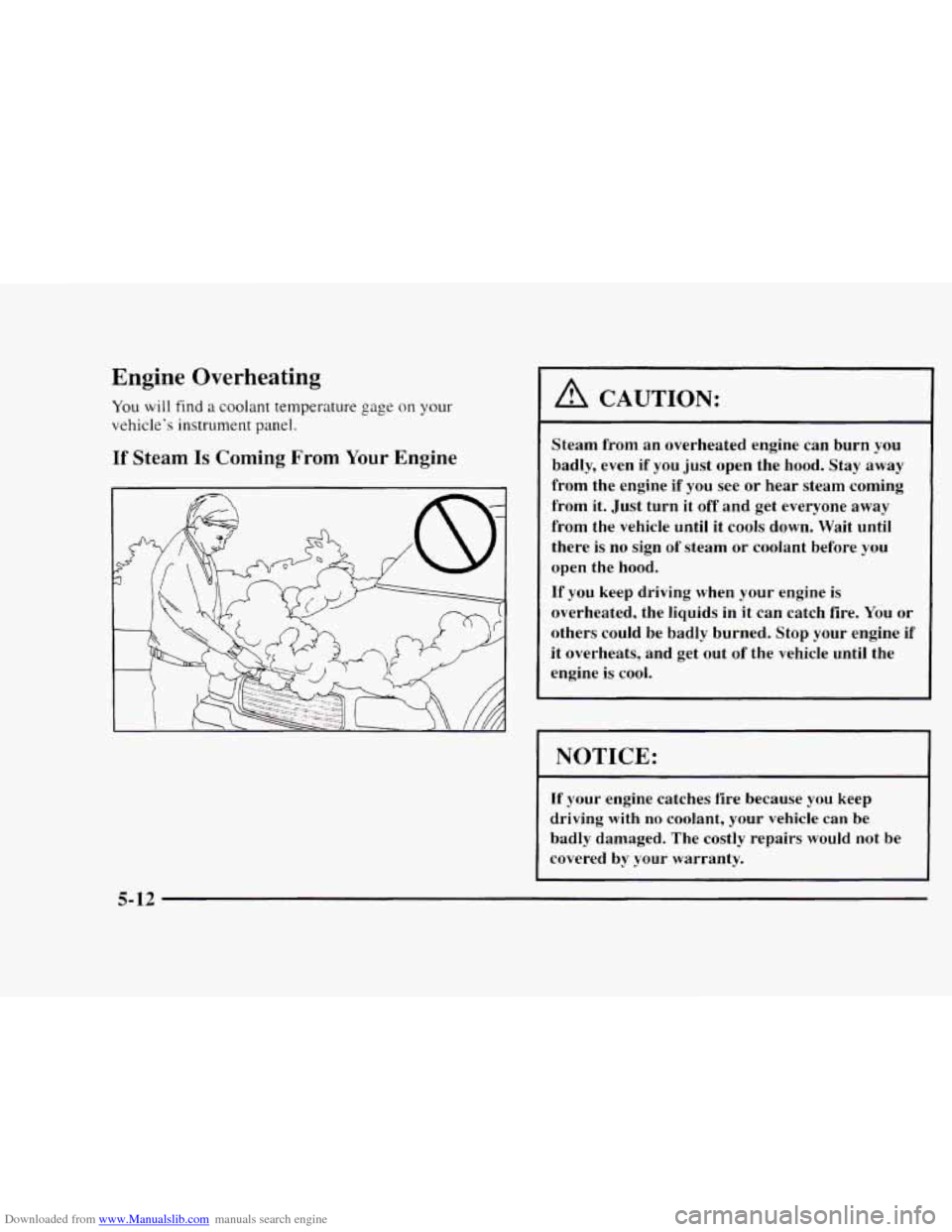
Downloaded from www.Manualslib.com manuals search engine Engine Overheating
You will find a coolant temperature gage on your
vehicle’s instrument panel.
If Steam Is Coming From Your Engine
A CAUTION:
Steam from an overheated engine can burn you
badly, even
if you just open the hood. Stay away
from the engine
if you see or hear steam coming
from it. Just turn
it off and get everyone away
from the vehicle until it cools down. Wait until
there is
no sign of steam or coolant before you
open the hood.
If you keep driving when your engine is
overheated, the liquids in it can catch fire.
You or
others could be badly burned. Stop your engine if
it overheats, and get out
of the vehicle until the
engine
is cool.
NOTICE:
If your engine catches fire because you keep
driving with no coolant, your vehicle can be
badly damaged. The costly repairs would not be
covered
by your warranty.
5-12
Page 278 of 402
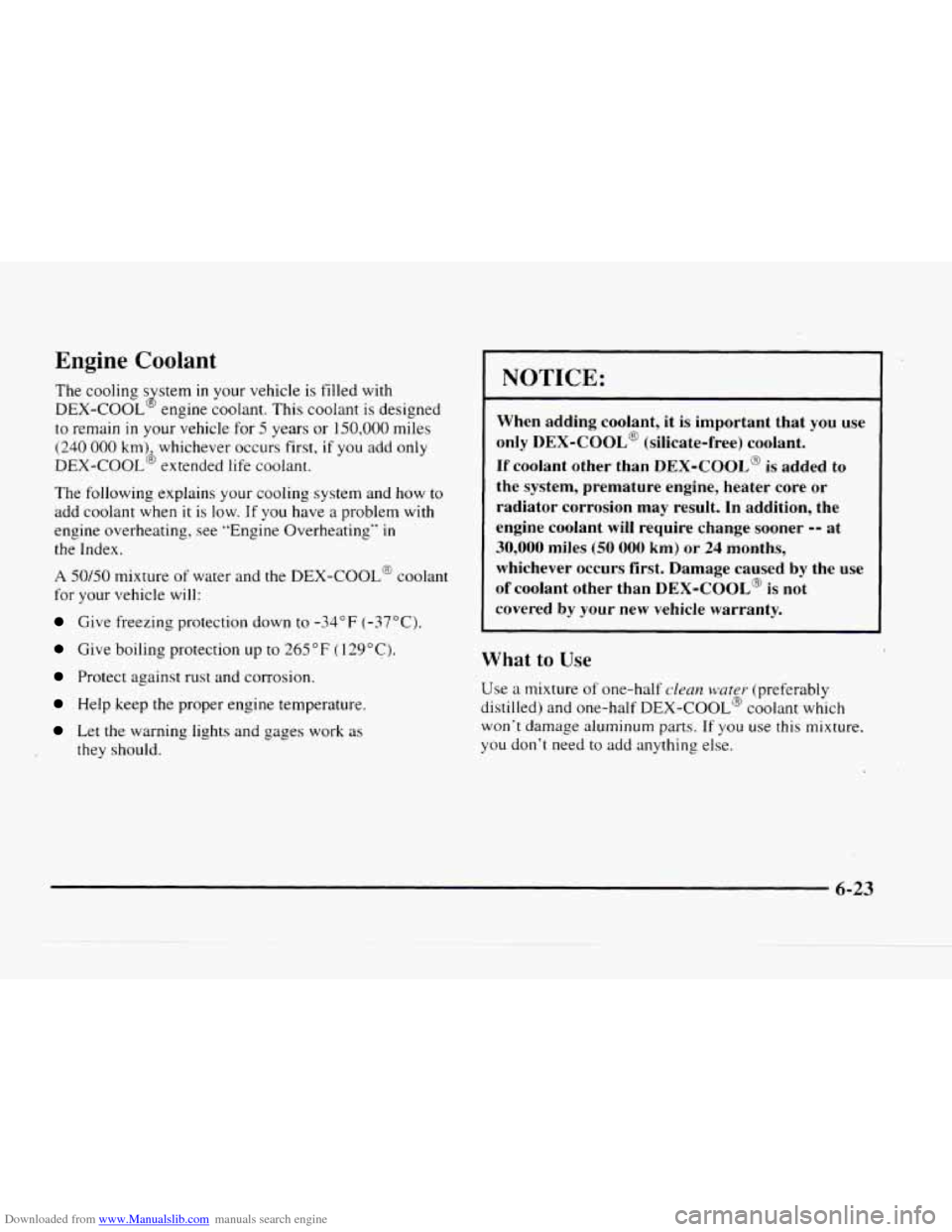
Downloaded from www.Manualslib.com manuals search engine Engine Coolant
The cooling s stem in your vehicle is filled with
DEX-COOL engine coolant. This cooIant is designed
to remain in your vehicle for 5 years or 150,000 miles
(240
000 km) whichever occurs first, if you add only
DEX-COOL’ extended life coolant.
The following explains your cooling system and
how to
add coolant when
it is low. If you have a problem with
engine overheating, see “Engine Overheating”
in
the Index.
A 50/50 mixture of water and the DEX-COOL@ coolant
for your vehicle will:
Give freezing protection down to -34°F (-37°C).
Give boiling protection up to 265 “F ( 129°C).
Protect against rust and corrosion.
Help keep the proper engine temperature.
Let the warning lights and gages work as
J
they should.
NOTICE:
When adding coolant, it is important that you use
only
DEX-COOL@ (silicate-free) coolant.
If coolant other than DEX-COOL@ is added to
I the system, premature engine, heater core or
radiator corrosion may result. In addition, the
engine coolant
will require change sooner -- at
30,000 miles (50 000 km) or 24 months,
whichever occurs first. Damage caused
by the use
of coolant other than DEX-COOL@ is not
covered
by your new vehicle warranty.
What to Use
Use a mixture of one-half clean water (preferably
distilled) and one-half DEX-COOL@ coolant which
won’t damage aluminum parts.
If you use this mixture.
you don’t need to add anything else.
6-23
Page 281 of 402

Downloaded from www.Manualslib.com manuals search engine Radiator Pressure Cap
a
NOTICE:
Your radiator cap is a 15 psi (105 kPa)
pressure-type cap and must be tightly installed to
prevent coolant
loss and possible engine damage
from overheating. Be sure the arrows on the cap
line up with the overflow tube on the radiator
filler neck.
Thermostat
Engine coolant temperature is controlled by a thermostat
in the engine coolant system. The thermostat stops the
flow of coolant through the radiator until the coolant
reaches
a preset temperature.
Power Steering Fluid
... .. . ., - --.
6-26
Page 296 of 402
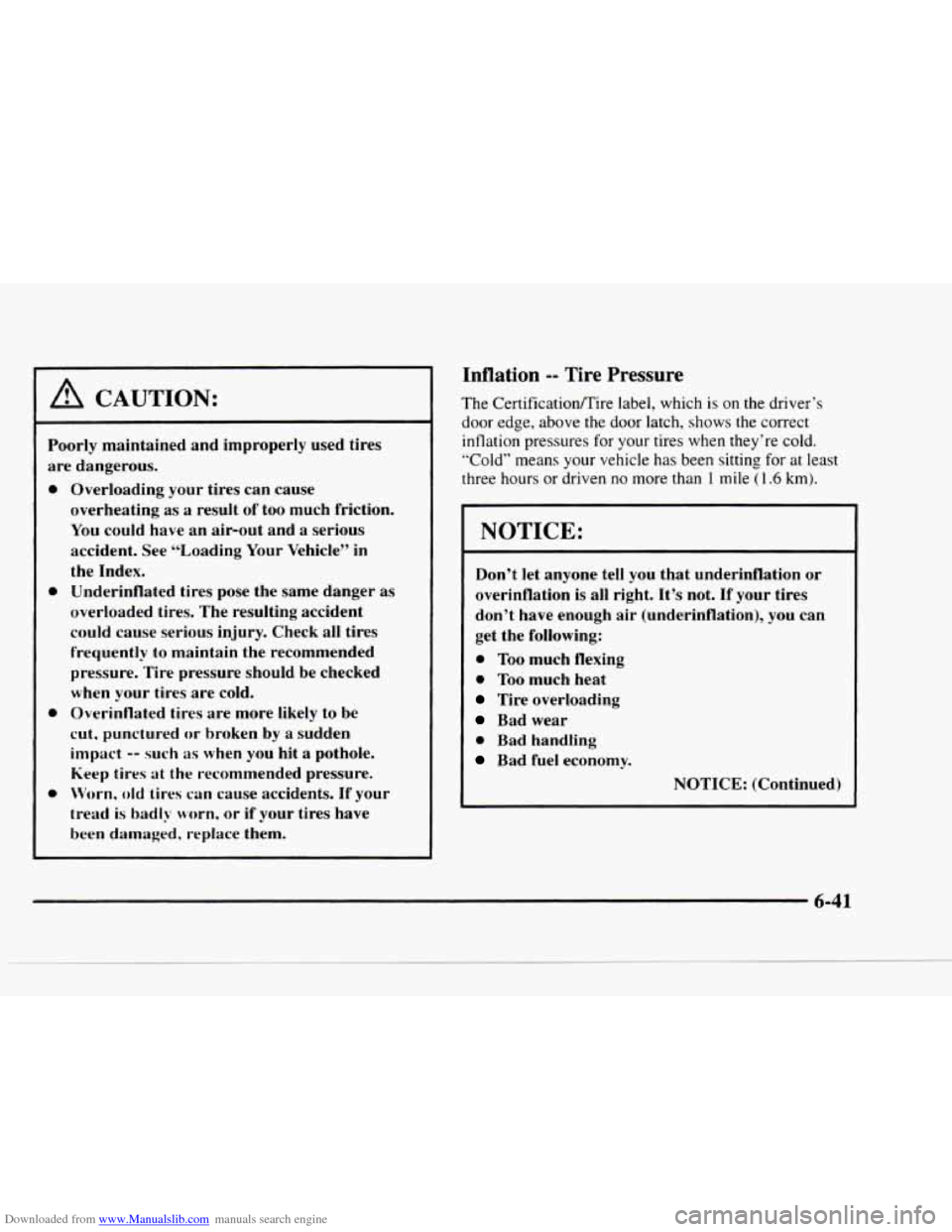
Downloaded from www.Manualslib.com manuals search engine ~ ~~~ ~~~ Poorly maintained and improperly used tires
are dangerous.
0
0
0
0
Overloading your tires can cause
overheating
as a result of too much friction.
You could have an air-out and
a serious
accident. See “Loading Your Vehicle”
in
the Index.
Underinflated tires pose the same danger
as
overloaded tires. The resulting accident
could cause serious injury. Check all tires
frequently to maintain the recommended
pressure. Tire pressure should be checked
when your tires are cold.
Overinflated tires are more likely to
be
cut, punctured or broken by a sudden
impact
-- such as when you hit a pothole.
Keep tires at the recommended pressure.
Worn, old tires can cause accidents. If your
tread
is badly worn, or if your tires have
been damaged. replace them.
Inflation -- Tire Pressure
The CertificationRire label, which is on the driver’s
door edge, above the door latch, shows the correct
inflation pressures for your tires when they’re cold.
“Cold” means your vehicle has been sitting for at least
three hours or driven no more than
1 mile (1.6 km).
NOTICE:
Don’t let anyone tell you that underinflation or
overinflation is
all right. It’s not. If your tires
don’t have enough air (underinflation), you can
get the following:
0 Too much flexing
0 Too much heat
Tire overloading
Bad wear
0 Bad handling
Bad fuel economy.
NOTICE: (Continued)
6-41
Page 393 of 402
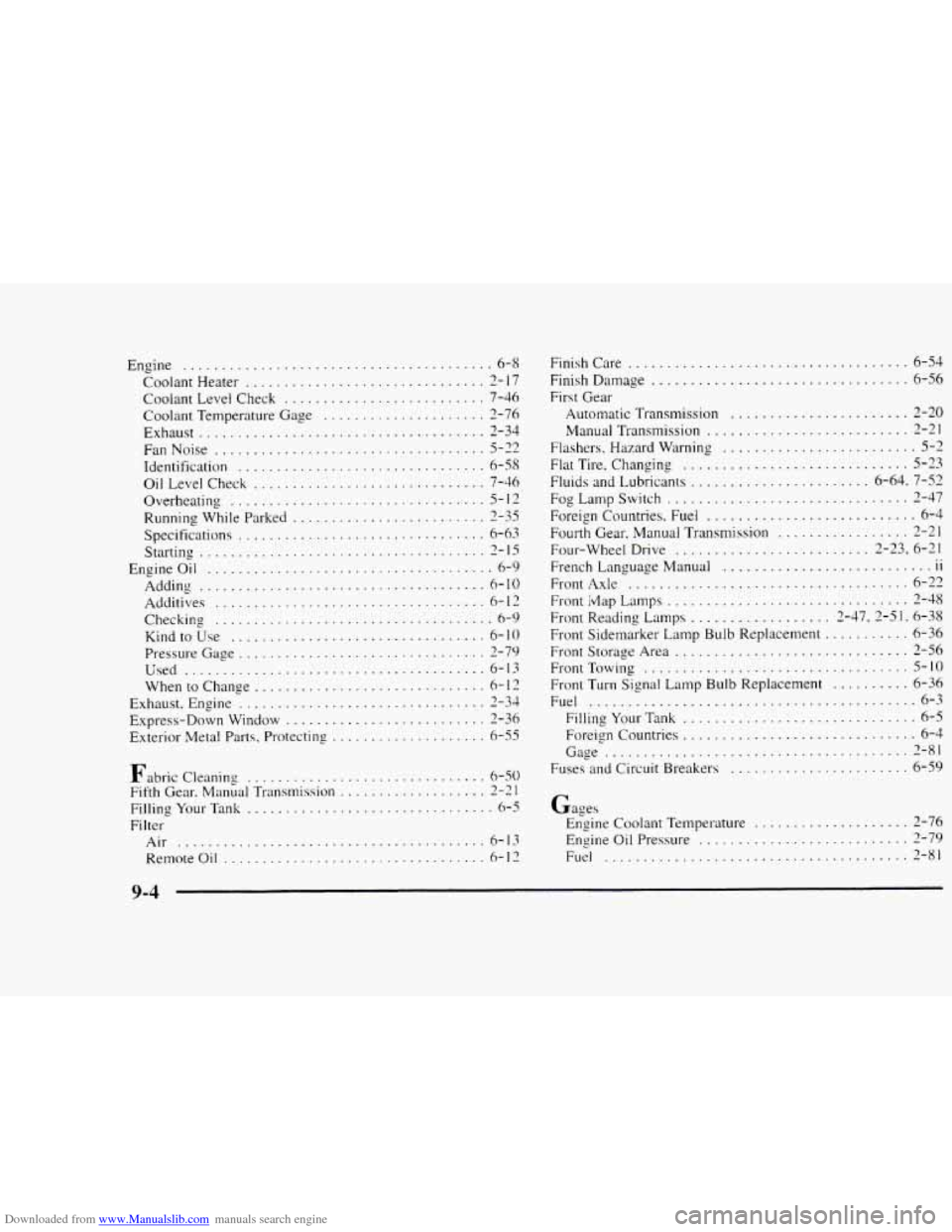
Downloaded from www.Manualslib.com manuals search engine Engine ........................................ 6-8
Coolant Heater
............................... 2- 17
Coolant Level Check
.......................... 7-46
Coolant Temperature Gage
..................... 3-76
Exhaust ..................................... 2-34
FanNoise
................................... 5-22
Identification ................................ 6-58
Oil Level Check .............................. 7-46
Running While Parked ......................... 2-35
Specifications ................................ 6-63
Overheating
................................. 5-12
Starting
..................................... 2-15
Engineoil
..................................... 6-9
Adding ..................................... 6-10
Additives ................................... 6- 12
Checking .................................... 6-9
Kind to Use ................................. 6-10
Pressure Gage ................................ 2-79
Used
....................................... 6-13
Whentochange .............................. 6-12
Exhaust.Engine
................................ 2-34
Express-Down Window .......................... 3-36
Exterior Metal Parts. Protecting
.................... 6-55
Fabric Cleaning
............................... 6-50
Fifth Gear
. Manual Transmission ................... 2-21
FillingYourTank ................................ 6-5
Fi 1 ter
Air
........................................ 6-13
Remote Oil .................................. 6- 12
Finish Care .................................... 6-54
Finish Damage
................................. 6-56
First Gear
Automatic Transmission
....................... 2-20
Manual Transmission .......................... 2-21
Flashers
. Hazard Warning ......................... 5-2
Flat Tire . Changing ............................. 5-23
Fluids and Lubricants ....................... 6-64. 7-52
FogLampSwitch ............................... 2-47
Foreign Countries. Fuel
........................... 6-4
Fourth Gear, Manual Transmission ................. 2-21
Four-wheel Drive ......................... 2-23, 6-21
French Language Manual 11
FrontAxle .................................... 6-22
.. ...........................
Front ivlap Lamps ............................... 2-48
Front Reading Lamps .................. 2-47. 2-5 1.6-38
Front Storage Area
.............................. 2-56
Front
Sidemarker Lamp Bulb Replacement
........... 6-36
FrontTowing
.................................. 5-10
Front Turn Signal Lamp Bulb Replacement .......... 6-36
Fuel .......................................... 6-3
Filling Your Tank .............................. 6-5
Foreign Countries
.............................. 6-4
Gage ....................................... 2-81
Fuses and Circuit Breakers ....................... 6-59
Gages Engine Coolant Temperature
.................... 2-76
Engine Oil Pressure ........................... 2-79
Fuel
....................................... 2-81
9-4